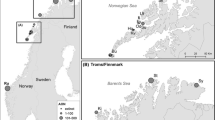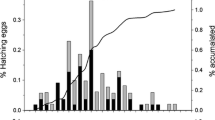Summary
The Lesser Sheathbill Chionis minor is an opportunistic predator and scavenger that breeds on sub-Antarctic islands during the summer season, when many other seabirds are present, especially penguins on which it is kleptoparasitic. It is a poor flyer and over-winters on its breeding grounds, where it faces a diminished food supply and low temperatures. Its foraging behaviour was suspected to be plastic enough to respond to such a variable environment, and we show how this species enlarged its niche to survive in winter. Population movements, dietary changes and monthly weight gains were quantified during a 13-month period of observation. Mortality rates, calculated over a 19-year period of banding, appeared to be age dependent: they decrease, due to competition, from juveniles to subadults, adult non-breeders, and breeders. One of the survival strategies described here is, to our knowledge, unique among birds. After the Crested Penguin colonies have been deserted, some adult sheathbills (mainly females) remained territorial, extending their territory size and diet while their partners moved to previously undefended zones in King Penguin colonies (permanent and large in the Crozet archipelago), where they competed for a winter territory and subsequently associated with another mate. After this winter mating, mobile sheathbills returned the following summer to their breeding territory and previous mate.
Similar content being viewed by others
References
Bost CA, Jouventin P (1990) Evolutionary ecology of the Gentoo penguin Pygoscelis papua. In: Davis LS, Darby J (eds) Penguins. Academic Press, Orlando
Bradley JS, Wooller RD, Skira IJ, Serventy DL (1989) Age-dependent survival of breeding short-tailed shearwaters Puffinus tenuirostris. J Anim Ecol 58:175–188
Brown JL (1982) Optimal group size in territorial animals. J Theor Biol 95:793–810
Burger AE (1979) Breeding biology, moult and survival of Lesser Sheathbills Chionis minor at Marion Island. Ardea 67:1–14
Burger AE (1980a) An analysis of the displays of Lesser Sheathbills Chionis minor. Z Tierpsychol 52:381–396
Burger AE (1980b) Sexual size dimorphism and aging characters in the Lesser Sheathbills at Marion Island. Ostrich 51:39–43
Burger AE (1981a) Food and foraging behaviour of Lesser Sheathbill at Marion Island. Ardea 69:167–180
Burger AE (1981b) Time budgets, energy needs and kleptoparasitism in breeding Lesser sheathbills (Chionis minor). Condor 83:106–112
Burger AE (1982) Foraging behaviour of Lesser Sheathbills Chionis minor exploiting invertebrates on a sub-antarctic island. Oecologia 52:236–245
Burger AE (1984) Winter territoriality in Lesser Sheathbills on breeding grounds at Marion Island. Wilson Bull 96:20–33
Burmeister A, Jurkschat M, Nichelmann M, Postel T (1989) The influence of age, wind speed and ambient temperature on nonevaporative heat loss in Turkeys (Meleagris gallopavo). J Therm Biol 14(3):139–145
Carrick R (1963) Territory in the Australian Magpie. In: Proc XIIIth Int Ornithol Congr, pp 740–753
Carrick R (1972) Population ecology of the Australian Blackbacked Magpie, Royal Penguin and Silver Gull. In: Population Ecology of Migratory Birds: A symposium. US Department of the Interior, Wildlife Research Report 2
Colinvaux PA (1982) Towards a theory of history: fitness, niche and clutch of Homo sapiens. Ecology 70:393–412
Conover MR, Hunt GL (1984) Female-female pairing and sex-ratio in gulls: an historical perspective. Wilson Bull 96:619–625
Cormack RM (1964) Estimates of survival from the sighting of marked animals. Biometrika 51:429–438
Croxall JP (1982) Aspects of the population demography of antarctic and subantarctic seabirds. CNFRA 51:479–488
Davies NB (1982) Territorial behaviour of Pied wagtail in winter. Br Birds 75:262–267
Elton CS (1927) Animal ecology. Macmillan, New York
Emlen ST (1984) Cooperative breeding in birds and mammals. In: Krebs JR, Davies NB (eds) Behavioural ecology, 2nd ed. Sinauer, Sunderland, Massachusetts, pp 305–309
Grinnell J (1914) An account of the mammals and birds of the Lower Colorado Valley with special reference to the distributional problems presented. Univ Calif Publ Zool 12:51–294
Grinnell J (1917) The niche-relationships of the California Thrasher. Auk 34:427–433
Grinnell J (1924) Geography and evolution. Ecology 5:225–229
Grinnell J (1928) Presence and absence of animals. Univ Calif Chronicle 30:429–450
Hatch J (1966) Collective territories in Galapagos mockingbirds, with notes on other behavior. Wilson Bull 78:198–207
Jouventin P, Mougin JL, Stahl JC, Weimerskirch H (1984) The seabirds of the French Subantarctic Islands & Adelie Land. Status and conservation of the world's seabirds. ICBP Tech Pub 2:609–625
Jouventin P, Weimerskirch H (1990) Satellite tracking of Wandering albatrosses. Nature 343:746–748
Jouventin P, Weimerskirch H (1991) Analysis of past and present changes in the number of seabirds of French Antarctic and Subantarctic territories and its implication for the management of Southern populations. In: Perrins CN, Lebreton JD (eds) Bird population studies: their relevance to conservation and management, Oxford University Press, Oxford
Klopfer PH (1962) Behavioural aspects of ecology. Prentice-Hall, Englewood Cliff, New-Jersey
Kovacs KM, Ryder JP (1985) Morphology and physiology of female pair members. Auk 102:874–878
Lack D (1946) Do juvenile birds survive less well than adults? Br Birds 39:258–264
Ligon JD (1983) Cooperation and reciprocity in avian social systems. Am Nat 121:366–384
Loery G, Pollock KH (1987) Age-specificity of Black-capped chickadee survival rates: analysis of capture-recapture data. Ecology 68(4):1038–1044
Marzluff JM, Balda RP (1988) Resource and climatic variability: influences on sociality of two southwestern corvids. In: Slobodchikoff CN (ed) The ecology of social behaviour. Academic Press, San Diego, pp 255–283
Mayr E (1963) Population, species and evolution. Oxford University Press
Mayr E (1974) Behavior programs and evolutionary strategies. Am Scientist 62:650–659
Olsen KM (1985) Pair of apparently adult male kestrel. Br Birds 78:452
Plotkin HC (ed) (1988) The role of behavior in evolution. MIT Press, Cambridge, Massachusetts
Ricklefs RE (1973) Fecundity, mortality and avian demography. In: Famer DS (ed) Breeding biology of birds. National Academy of Sciences, Washington DC, pp 366–435
Schoener TW (1971) Theory of feeding strategies. Ann Rev Ecol Syst 11:369–404
Schoener TW (1989) The ecological niche. In: Cherrett JM (ed) Ecological concepts. Blackwell Scientific Publications, Oxford
Seber GAF (1973) The estimation of animal abundance. Hafner, New York
Shaw P (1986) The relationship between dominance behaviour, bill size and age group in Greater Sheathbills Chionis alba. Ibis 128:48–56
Stahl JC, Derenne P, Jouventin P, Mougin JL, Teulieres L, Weimerskirch H (1985) Le cycle reproducteur des gorfous de l'archipel Crozet: Eudyptes chrysolophus, le gorfou macaroni et E. chrysocome, le gorfou sauteur. L'Oiseau et la. RFO 55:27–43
Stanier MW, Mount LE, Bligh J (1984) Energy balance and temperature regulation. Cambridge texts in the physiological sciences 4, Cambridge University Press, Cambridge
Stephens DW, Krebs JR (1986) Foraging theory, Princeton University Press, Princeton, New Jersey
Svärdson G (1949) Competition and habitat selection in birds. Oïkos 34:157–174
Verheyden C (1988) La formation de couples hivernaux chez le petit Bec-en-fourreau (Chionis minor) et sa signification biologique. Rev Ecol (Terre Vie) 43:47–59
Voous KH (1957) The birds of Aruba, Curaçao, and Bonaire. In: Hummelinck PH (ed) Studies of the fauna of Curaçao and other Caribbean islands, vol 7, pp 1–260. Martinus Nijhoff, The Hague
Watkins BP (1987) Population sizes of King, Rockhopper and Macaroni Penguins and Wandering Albatrosses at the Prince Edward Islands and Gough Islands 1951–1986. S Afr J Antarct Res 17:155–162
Watson GE (1975) Birds of the Antarctic and sub-Antarctic. American Geophysical Union, Washington, DC
Weimerskirch H, Stahl JC (1988) The breeding and feeding ecology of the Kerguelen tern Sterna virgata. Ornis Scand 19:199–204
Weimerskirch H, Jouventin P, Stahl JC (1986) Comparative ecology of the six albatross species breeding on the Crozet Islands. Ibis 128:195–213
Author information
Authors and Affiliations
Rights and permissions
About this article
Cite this article
Verheyden, C., Jouventin, P. Over-wintering strategies of the Lesser Sheathbill Chionis minor in an impoverished and insular environment. Oecologia 86, 132–139 (1991). https://doi.org/10.1007/BF00317400
Received:
Accepted:
Issue Date:
DOI: https://doi.org/10.1007/BF00317400




